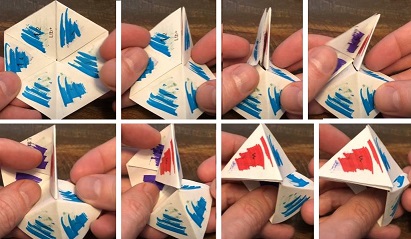A chapter from
Explorable Flexagons
Next chapter:
New Flexes
Slot Flexes
Flexes that involve sliding leaves through slots
The common start to several of the slot flexes:

The class of slot flexes all involve sliding leaves through a slot, combined with other moves such as pocket flexes and tuck flexes. There are lots of possible ways to combine various moves, so this chapter will just cover a fraction of what’s out there to explore.
Pinch Complements
Say you have a pair of flexes A and B, some starting state s,
state a that you get when you apply flex A from s,
and state b that you get when you apply flex B from s.A and B are pinch complements if you can pinch flex from state a to state b
if the flexagon has enough internal structure to support it.
On a hexaflexagon, the following pairs of slot flexes are pinch complements of each other.
Lhslot half flex andLkslot pocket flexLtfslot tuck top front andLtbslot tuck top backLbfslot tuck bottom front andLbbslot tuck bottom back
The chapter will conclude with the slot triple pocket L3 on a pentaflexagon.
Slot half and slot pocket
Slot half flex: Lh
TT'VLhLtbLtb'.
Slot pocket flex: Lk
The slot pocket flex requires 12 leaves.
You can flex to 12 different arrangements on the minimal Lk flexagon
by using the following flexes: TT'SLkLtf.
There’s an alternate way to do the slot pocket flex, where you start with two pocket flexes instead of one. Can you figure out how to do it?

With the following template, tape together the two edges labeled *a* before folding it as usual.
Generating sequence: Lh+Lk+
The slot half flex and slot pocket flex are pinch complements.
After you do the slot, there are two different ways to open the flexagon back up
if the structure of the flexagon supports it.
Opening it up one way is the Lh and the other is the Lk.
Using a generating sequence of Lh+Lk+ creates the necessary structure.
It’s interesting to note that you can pinch flex between these two states.
Try Lh < P Lk' or Lk < P > P Lh' to see how this works.
Slot tuck flexes
The slot tuck flexes all start out the same way: slide leaves through a slot till you’re looking at a position where you could apply a tuck at the top or the bottom. Once you do a top or bottom tuck, you can choose to open the flexagon from either the front or back. This gives you a total of 4 different ways to complete the flex.
Ltf: slot tuck top frontLtb: slot tuck top backLbf: slot tuck bottom frontLbb: slot tuck bottom back
Slot tuck top front: Ltf
Ltf and Ltf'.
With the following template, tape together the two edges labeled *a* before folding it as usual.
Slot tuck top back: Ltb
Ltb and Ltb'.
Generating sequence: Ltf+Ltb+
The slot tuck top front and slot tuck top back are pinch complements.
After you do the slot and tuck, there are two different ways to open the flexagon back up
if the structure of the flexagon supports it.
Opening it up one way is the Ltf and the other is the Ltb.
Using a generating sequence of Ltf+Ltb+ creates the necessary structure.
You can pinch flex between these two states.
Try Ltf > P < P Ltb' or Ltb < P Ltf' to see how this works.
Slot tuck bottom front: Lbf
The slot tuck bottom front requires 10 leaves.
You can flex to 5 different arrangements on the minimal Lh flexagon
by using the following flexes: VLbfLbf'.
It’s also interesting to note that it rearranges the leaves in exactly the same way as V,
but V only requires 9 leaves.

Slot tuck bottom back: Lbb
The slot tuck bottom back requires 11 leaves.
You can flex to 9 different arrangements on the minimal Lbb flexagon
by using the following flexes: PTT'VLbfLbf'LbbLbb'.
Notice that the minimal Lbb also supports Lbf, its pinch complement.
Try Lbf P < P Lbb' or Lbb < P > Lbf'.

Generating sequence: Lh+Lk+Lbb+
Lh+Lk+Lbb+ gives you a flexagon that supports all 6 slot flexes we’ve discussed so far.
If you combine these with flexes from previous chapters
(the pinch flex P, pyramid shuffle S, tuck flex T, and v-flex V),
there are 117 different configurations reachable with combinations of those flexes.
You can quickly get lost, so if you try it on a paper model,
don’t be afraid to take the flexagon apart and refold it if you want to restart your explorations.
Slot triple pocket: L3
L3+ gives you a flexagon with 14 leaves that supports
the slot triple pocket (L3), the slot pocket (Lk), slot tuck top front (Ltf), and the pyramid shuffle (S).
There are 24 different arrangements available using those flexes.
What next?
This chapter showed a variety of slot flexes on the hexaflexagon and pentaflexagon. But you can also do flexes such as the slot tuck top front and slot pocket on the heptaflexagon, octaflexagon, etc. You could try these out at the Flexagon Playground. And there are other ways you could try combining slots with various flexes on paper flexagons. Feel free to experiment!
Return to the Table of Contents.
